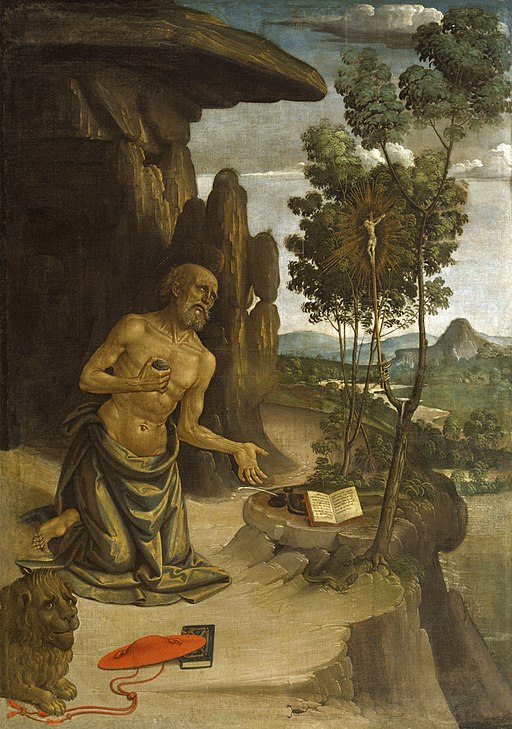
If you’re an interpreter or translator and you have a terrible, no good, horrible day you can call on the patron saint of translators, Saint Jerome. People who believe in saints may receive comfort, calm, and reassurance from appealing to the patron saint charged with their particular cause, occupation, or need.
In Latin, Saint Jerome is known as Eusebius Sophronius Hieronymus. His name in Ancient Greek is Εὐσέβιος Σωφρόνιος Ἱερώνυμος. In his life ( 347 A.D. to 420 A.D.) Saint Jerome was a Latin Christian priest, confessor, theologian, and historian. He became a Doctor of the Church and is best known for his translation of the Bible into Latin (the Vulgate), and his commentaries on the Christian Bible’s Gospel of the Hebrews.
What Is A Patron Saint?
A patron saint is regarded as an intercessor, special guardian, and advocate in heaven for a nation, place, craft, activity, class, or person. Saint Jerome is recognized as a saint by the Catholic Church, the Eastern Orthodox Church, the Lutheran Church, and the Church of England (Anglican Communion). He is the patron saint of archeologists, archivists, Bible scholars, librarians, libraries, school children, students, and translators.
The Purposes Of Patron Saints
The Catholic Church cites two reasons for having patron saints. First, patron saints serve as models. In the case of Saint Jerome, translators and interpreters can pattern their behavior after Jerome or use him as an example. The second reason for patron saints is to use them for intercessory prayer. Catholics can ask patron saints to pray to God for them. This is common among Eastern Orthodox, Oriental Orthodox, Roman Catholic, and Eastern Catholic practice.
Superficial Escapades And Wanton Behavior
But being recognized by the church as a saint doesn’t mean Jerome lived a perfect life. When Saint Jerome was a student in Rome, Wikipedia says he engaged in superficial escapades and wanton behavior. He indulged in these acts quite casually but suffered terrible bouts of repentance afterwards. To appease his conscience, he would visit the sepulchers of the martyrs and the Apostles in Rome’s catacombs. This experience reminded Saint Jerome of the terrors of hell.
Translating The Bible From Hebrew
Jerome was a scholar at a time when that statement implied a fluency in Greek. He knew some Hebrew when he started translating, but moved to Jerusalem to strengthen his grip on Jewish scripture commentary. Saint Jerome corrected the existing Latin language version of the New Testament, commonly referred to as the Vetus Latina. By 390 he turned to translating the Hebrew Bible from the original Hebrew, having previously translated portions from the Septuagint which came from Alexandria.
A Good Example For Translators
According to the Translator Interpreter Hall of Fame, Jerome’s humility regarding his own translation work set a good example for translators who followed him. Saint Jerome freely admitted ignorance, even embarrassment, when warranted, and revisited some of his translations, making corrections and additions. On the other hand, Jerome also pointed out that a translation’s accuracy depended greatly on the reliability of the source text. In Jerome’s day, copyists often inadvertently introduced errors, which would be compounded and passed down through the centuries.
Mistranslation Puts Horns On Moses
Perhaps Jerome’s most famous mistranslation put horns on Moses’ head. The original Hebrew scripture (Exodus 34) stated that when Moses descended from Mt. Sinai, he had “rays of light” coming from his head. The Hebrew word for rays of light can also mean “horns.” Saint Jerome chose the latter meaning. This error has been perpetuated to the present in many ways. When Michelangelo sculpted a marble Moses in 1515, he relied on Jerome’s description in the Latin Vulgate translation. The resulting 235-cm-high horned statue can be seen in Rome (S. Pietro in Vincoli) today.
Jerome was the first honoree inducted into the Translator Interpreter Hall of Fame (TIHOF). TIHOF was founded on September 30, 2000, to recognize the achievements of and pay tribute to the men and women who have helped penetrate cultural and linguistic barriers between the world’s peoples.
Language specialists the world over observe International Translators Day every year on September 30, the Feast Day of St. Jerome, the patron saint of translators.
Featured photo By Pinturicchio – Walters Art Museum: Home page Info about artwork, Public Domain,
Last Updated October-5-2016






Comments are closed here.